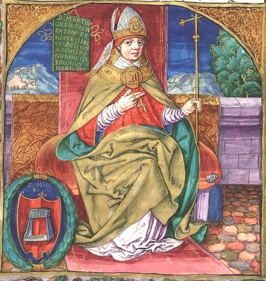- Martin of Opava
-
Martin of Opava, also known as Martin of Poland, was a 13th century chronicler.
Known in Latin as Frater Martinus Ordinis Praedicatorum (Brother Martin of the Dominican order), he is believed to have been born, at an unknown date, in the Silesian town of Opava (German: Troppau), thus sometimes called Martinus Oppaviensis, or also Martinus Polonus, due to his home convent being assigned to the Poland-based branch of the Dominican order. In German he appears as Martin von Troppau and in Czech as Martin z Opavy.
From the middle of the 13th century, he was active in Rome, as penitentiary and capellanus for Pope Alexander IV and his successors, Pope Urban IV, Pope Clement IV, Pope Gregory, Pope Innocent V, Pope Adrian V and Pope John XXI (d. 1277), the last pope to appear in his chronicles. On 22 June 1278, Pope Nicholas III, while in Viterbo, appointed him Archbishop of Gniezno. While travelling to his see in the same year, Martinus died in Bologna, where he was buried in St. Dominic's church.[1]
Martin's Latin chronicle, the Chronicon pontificum et imperatorum, was intended for the school-room. It is mostly derivative in content and is therefore of limited value to modern historians. However, its importance is in the way the material is presented, which is a quantum leap forward in didactic method. The genius lies in its layout; each double page covers fifty years with fifty lines per page. The left-hand pages give the history of the papacy, with one line per year, and the right-hand pages give the history of emperors, the two accounts being kept strictly parallel. This was a revolutionary approach in graphic design, which was not appreciated by all his contemporaries: many manuscripts simply copy the text without retaining the page layout, which results in a rather chaotic chronology. The chronicle was enormously influential; over 400 manuscripts are known, and the influence on many dozens of later chroniclers is palpable. Translations were made into many medieval vernaculars, including Middle English, as well as an Old French translation by Sébastien Mamerot. Martin's Chronicon is the most influential source for the legend of "Pope Joan", which was only added in the latest edition, probably after his death.
Other works include the Promptuarium Exemplorum.
References
- ^ Michel de La Roche: Memoirs of Literature: Containing a Large Account of Many Valuable Books ... , 1722 [1]
Literature
- Anna-Dorothee von den Brincken: Studien zur Überlieferung der Chronik des Martin von Troppau (Erfahrungen mit einem massenhaft überlieferten historischen Text). In. DA 41 (1985), S. 460–531.
- Wolfgang-Valentin Ikas: Martinus Polonus' Chronicle of the Popes and Emperors. A Medieval Best-seller and its Neglected Influence on English Medieval Chroniclers. In: The English Historical Review 116 (2001), S. 327-341 (also ISBN 3895003131)
- Wolfgang-Valentin Ikas: Neue Handschriftenfunde zum Chronicon pontificum et imperatorum des Martin von Troppau. In: Deutsches Archiv für Erforschung des Mittelalters 58 (2002), S. 521-537
- Wolfgang-Valentin Ikas: Martin von Troppau (Martinus Polonus), O.P. (gest. 1278) in England. Überlieferungs- und wirkungsgeschichtliche Studien zu dessen Papst- und Kaiserchronik. (Wissensliteratur im Mittelalter 40) Wiesbaden: Verlag Dr. Ludwig Reichert 2002. ISBN 3-89500-313-1 Review article
- Ludwig Weiland (Hg.): Martini Oppaviensis chronicon pontificum et imperatorum. MGH SS 22 (1872), S. 377–475 Faksimile bei Gallica
- H. Daniel Embree (Hg.): The Chronicles of Rome. An Edition of the Middle English 'The Chronicle of Popes and Emperors' and 'The Lollard Chronicle'. Woodbridge 1999.
External links
- Digital facsimile of a German translation of his chronicle in the Heidelberg manuscript Cpg 137
- Edition of this translation, 1858
- Dieter Berg (1993). Bautz, Traugott. ed (in German). Martin von Troppau. Biographisch-Bibliographisches Kirchenlexikon (BBKL). 5. Herzberg. cols. 923–926. ISBN 3-88309-043-3. http://www.bautz.de/bbkl/m/martin_v_t.shtml.
- Information about a French dissertation on the Promptuarium Exemplorum
Categories:- Members of the Dominican Order
- 13th-century Latin writers
- 1278 deaths
- People from Opava
- 13th-century historians
Wikimedia Foundation. 2010.

